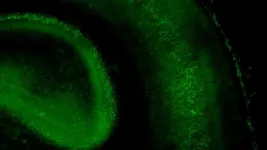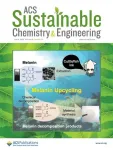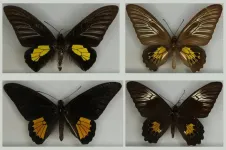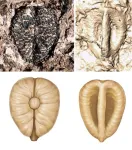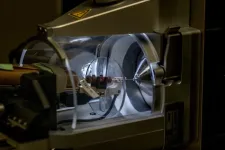(Press-News.org) Antibiotic resistant bacteria are experts in evolving new strategies to avoid being killed by antibiotics.
One such bacterium is Pseudomonas aeruginosa, which is naturally found in soil and water, but also hospitals, nursing homes and similar institutions for persons with weakened immune systems are home for strains of this bacterium. As many P. Aeruginosa strains found in hospitals are resistant to most antibiotics in use, science is forced to constantly search for new ways to kill them.
Now, at team of researchers from Department of Biochemistry and Molecular Biology and Department of Clinical Microbiology, University of Southern Denmark, have discovered a weakness in P. Aeruginosa with the potential to become the target for a new way to attack it. The team has published their findings in the journal Microbiology Spectrum, link https://journals.asm.org/doi/10.1128/spectrum.03875-23.The authors are Clare Kirkpatrick, Magnus Z. Østergaard, Flemming D. Nielsen and Mette H. Meinfeldt.
Thick and slimy biofilm
The team discovered a mechanism, that reduces the formation of biofilm on the surface of P. Aeruginosa. The formation of sticky, slimy biofilm is a powerful tool used by bacteria to protect themselves against antibiotics – a trick also used by P. Aeruginosa.
"This biofilm can be so thick and gooey that antibiotic cannot penetrate the cell surface and reach its target inside the cell", said Clare Kirkpatrick, head of research at Department of Biochemistry and Molecular Biology, adding:
"Maybe one day, we could pharmacologically stimulate this mechanism to reduce biofilm development on the surface of P. Aeruginosa."
Three new genes
Specifically, the researchers worked with three newly discovered genes in a lab-grown strain of P. Aeruginosa. When they overexpressed these genes, they saw a strong reduction of biofilm. Of significance is that the system affected by the genes is part of the P. Aeruginosa core genome, meaning that it is universally found in all the P. Aeruginosa strains sequenced so far.
"Being part of P. Aeruginosa’s core genome, this system has been found in all investigated strains of P. Aeruginosa, including a large variety of strains isolated from patients. So, there is reason to believe that reduction of biofilm via this system should be effective in all known strains of P. Aeruginosa", said Clare Kirkpatrick.
Bacteria strains can evolve individually and mutate quickly and constantly when they are under pressure. It is not uncommon for patients infected with a P. Aeruginosa strain to initially respond well to antibiotic treatment but then become resistant as the strain evolves resistance during treatment. Strains mutate, but their common core genome does not change.
Stressing the cell wall
In their experiments, the researchers activated the biofilm reducing system by overexpressing genes. But they also discovered that the system is naturally stimulated by cell wall stress.
"So, if we stress the cell wall, it may naturally lead to a reduction in biofilm, making it easier for antibiotic to penetrate the cell wall", said Clare Kirkpatrick, adding:
"Currently, cell wall-targeted drugs are not widely used against P. Aeruginosa, but perhaps, they could start to be used as additives to help reduce biofilm production and improve access of the existing antibiotics to the cells."
Bacteria cell wall is very different from human cell wall
When combating infectious bacteria, there are only a limited number of targets to attack. Targets found in both bacterial and human cells cannot be attacked, as the antibiotics would also affect human cells.
Bacterial cells and human cells have some targets in common, such as the process that replicates DNA and the processes controlling basic glucose metabolism or respiration in cells.
Among the targets unique to bacteria are various protein functions and also the bacterial cell wall is considered a suitable target, as it is very different from the human cell wall.
Clare Kirkpatrick is a microbiologist, associate professor and head of research at Department of Biochemistry and Molecular Biology. She studies how bacteria respond to antibiotic treatment and which of their genes make them resistant or sensitive. Profile and contact: https://www.sdu.dk/en/om_sdu/institutter_centre/bmb_biokemi_og_molekylaer_biologi/medarbejdere/academic/clare-kirkpatrick
Title: "The uncharacterized PA3040-3042 operon is part of the cell envelope stress response and a tobramycin resistance determinant in a clinical isolate of Pseudomonas aeruginosa".
Authors: Magnus Z Østergaard, Flemming D. Nielsen, Mette H. Meinfeldt, Clare Kirkpatrick.
Publication date: July 1st 2024, 9 AM ET.
Journal: Microbiology Spectrum.
DOI 10.1128/spectrum.03875-23
END
Researchers thwart resistant bacteria’s strategy
2024-07-01
ELSE PRESS RELEASES FROM THIS DATE:
Finding the sweet spot in brain development
2024-07-01
Not everything in the brain is meant to last. As our brains assemble, trillions of neural connections have to be built or torn down at the right time and place. Otherwise, the seeds of disorders like autism can take root. Cold Spring Harbor Laboratory Assistant Professor Gabrielle Pouchelon studies how the brain is wired early in life. In doing so, she hopes to find the origins of various brain dysfunctions and new ways to treat them.
In a new study, Pouchelon and her team zero in on a process known as pruning. This is when the brain removes unnecessary connections between ...
New national volunteer leaders to guide American Heart Association into second century
2024-07-01
DALLAS, July 1, 2024 — The American Heart Association, celebrating 100 years of lifesaving service as the world’s leading nonprofit organization focused on heart and brain health for all, has named its volunteer leadership for fiscal year 2024-25. Keith Churchwell, M.D., FAHA, serving as the new volunteer president, and Marsha Jones, continuing a two-year term as volunteer board chairperson, will help guide the Association as it enters its second century. Churchwell and Jones are long-time volunteer leaders for ...
Geological Society of America reduces student membership dues to $25
2024-07-01
FOR IMMEDIATE RELEASE
1 July 2024
The Geological Society of America
Release No. 24-06
Contact: Jason Elkins
+1-303-357-1026
jelkins@geosociety.org
Boulder, Colo., USA: The Geological Society of America (GSA) is excited to announce a significant reduction in membership fees for students. Effective 1 July 2024, undergraduate and graduate students majoring in geology or related sciences can sign up for an annual student membership for just $25. This initiative underscores GSA's commitment to supporting the next generation of geoscientists by making membership more accessible and affordable.
The ...
Melanin from cuttlefish ink as a sustainable biomass resource
2024-07-01
Every year, the negative effects of human activities on the environment become increasingly clear. From climate change and microplastics to the endangerment and extinction of countless species, it is evident that we need to find new ways to achieve sustainability. Fortunately, many research groups in prominent fields like chemistry and materials science are tirelessly working to develop solutions to get us closer to circular and sustainable economies.
One area that has attracted much attention in this regard is biomass upcycling. It refers to the transformation of naturally available organic materials into ...
AI-powered study explores under-studied female evolution
2024-07-01
Pioneering AI-powered research on butterflies has probed the under-studied evolution of females and adds to a debate between the founding fathers of evolution.
The University of Essex study – published in Communications Biology – explores a controversy between Victorian scientists Charles Darwin and Alfred Russel Wallace.
Darwin thought males had more variation, as females often chose mates based on male appearance.
Whereas Wallace thought natural selection across sexes was the biggest factor in difference.
For over a century, scientists ...
New findings may fix the replicability crisis in microbiome research
2024-07-01
Our bodies are inhabited by trillions of microorganisms, with specific microbes unique to each individual. Through experimentation, scientists have pinpointed certain factors that account for variation in the gut: diet, living conditions, exercise and maternal line. Now, scientists at University of California San Diego have discovered another factor that affects the composition of the gut microbiome: time of day. In fact, the scientists have found that time of day is such an important factor that they’re calling on the National Institutes of Health (NIH) to require researchers ...
Nanorobot with hidden weapon kills cancer cells
2024-07-01
Researchers at Karolinska Institutet in Sweden have developed nanorobots that kill cancer cells in mice. The robot’s weapon is hidden in a nanostructure and is exposed only in the tumour microenvironment, sparing healthy cells. The study is published in the journal Nature Nanotechnology.
The research group at Karolinska Institutet has previously developed structures that can organise so-called death receptors on the surface of cells, leading to cell death. The structures exhibit six peptides (amino acid chains) assembled in a hexagonal pattern.
“This hexagonal nanopattern of peptides becomes a lethal weapon,” explains Professor ...
Largest ever genetic study of age of puberty in girls shows links with weight gain
2024-07-01
Genes can indirectly influence the age at which girls have their first period by accelerating weight gain in childhood, a known risk factor for early puberty, a Cambridge-led study has found. Other genes can directly affect age of puberty, some with profound effects.
In the largest study of its kind to date, an international team led by researchers at the Medical Research Council (MRC) Epidemiology Unit, University of Cambridge, studied the DNA of around 800,000 women from Europe, North America, China, Japan, and Korea.
Published today in Nature Genetics, the researchers found more than 1,000 variants – small changes in DNA – that ...
Sixty-million-year-old grape seeds reveal how the death of the dinosaurs may have paved the way for grapes to spread
2024-07-01
If you’ve ever snacked on raisins or enjoyed a glass of wine, you may, in part, have the extinction of the dinosaurs to thank for it. In a discovery described in the journal Nature Plants, researchers found fossil grape seeds that range from 60 to 19 million years old in Colombia, Panama, and Peru. One of these species represents the earliest known example of plants from the grape family in the Western Hemisphere. These fossil seeds help show how the grape family spread in the years following the death of the dinosaurs.
“These are the oldest grapes ever found in this part of the world, and they’re a few million years ...
AI model finds the cancer clues at lightning speed
2024-07-01
Researchers at the University of Gothenburg have developed an AI model that increases the potential for detecting cancer through sugar analyses. The AI model is faster and better at finding abnormalities than the current semi-manual method.
Glycans, or structures of sugar molecules in our cells, can be measured by mass spectrometry. One important use is that the structures can indicate different forms of cancer in the cells.
However, the data from the mass spectrometer measurement must be carefully analysed by humans to work out the structure from the glycan fragmentation. This process can take anywhere from hours ...
